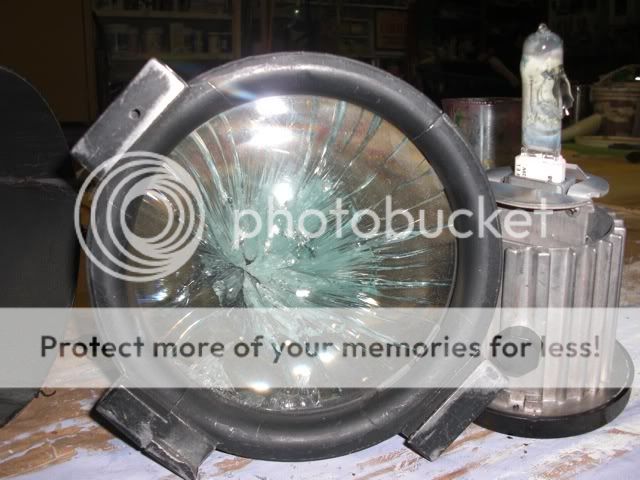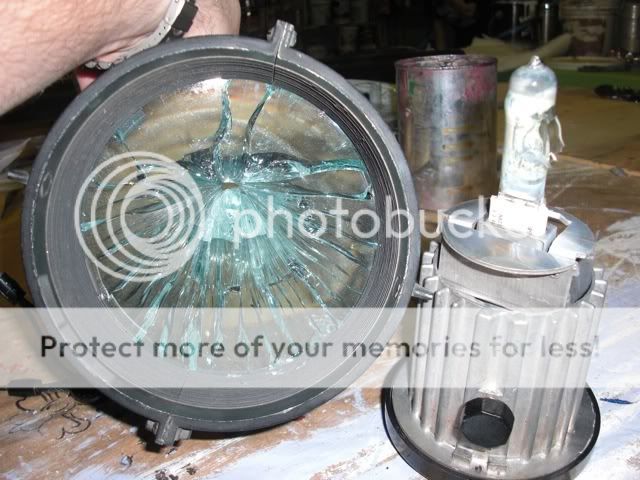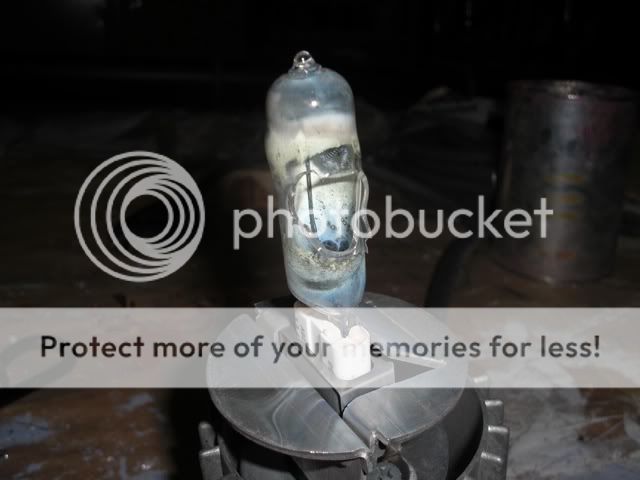Or at least take these photos to those that do the budget and say you would like to go GLC or GLD for high output or GLA or GLE for long life with similar ouput. It's a
safety issue as long as you don't tell them it's more of a fluke of
filament failure and rare.
That's an amazing "Kill Roy Was Here" failure as I named such a thing when the
filament of the lamp explodes out the side of the
globe as if gunshot with the glass lingering in cooling as if held in slow motion in how it bent out to reflect the
escape of the
filament.
Most likely on the opposing side of the lamp you will also see a puckering of the glass as the gasses in the lamp were sucked out. This shape of the puckered/sucked in glass in the case of an
incandescent lamp I noted with a
filament gunshot
thru the
globe, formed a "Kill Roy Was Here" shape on the sucked in side of the glass. Thus the name for it I have.
Most likely, it wasn't due to touching the lamp as initially assumed, just normal
halogen cycle in depositing
tungsten particles on the hottest part of the lamp - the center of the
filament, and for some reason as opposed to a normal failure, that
filament in where it broke and going arc lamp or as I
call "
super nova", it flying out the side of the
globe in that instant of while it's
super nova. Given a
halogen effect, that doesn't mean that spent
tungsten particles near the edges of the hangers or lead in part of the resistant
filament gets a re-deposit of
tungsten on it as spent, instead it often just goes to the center of the
filament in while it takes longer on
halogen lamps to wear out than on non-halogen,
incandescent lamps to wear out, still towards the
filament supports or lead in wires of a
halogen lamp, it can still wear out without replentishment. This area in a micro second often is also in normal and not
shock where is where once broken an arch of
current will develop until the resistance to
current flow is too much to continue with that much brighter now in being a arc light
intensity.
Given the
power of that instance of it being an arc light, there becomes at some
point so much pressure that there can be a blow out of the
filament given all support and lead in wires for it have not had sufficient replentishment of them so as to support them while going
super nova arc lamp as it were. At that
point that
filament resistor following the arc of
current no doubt starts flopping wildly in explosion and should it
escape during this also period of intense heat, that's about the end result. If nothing else, that's a lamp that lived well past it's expected lamp life if not got a shot of
voltage in failing. Normal failure just under conditions where the amperage applied to it was sufficient to continue completing the
circuit even if no longer connected to
power source. Bang! within a micro second that
filament escaped and the light goes out.
Rare and wouldn't be worried about happening, nor in this case it would seem did the
fixture other than protect the audience or talent below as designed should it happen. Wouldn't tell the management it's other than a problem and we need to change lamps given the lamp in use, but realistically there was no
safety hazzard. More just an excuse used to change to a better lamp.
The FEL ain't rated for most fixtures and even if rated for it, your's ain't efficient in using them as opposed to other lamps more recent to the market. It's a selling
point for more efficient lamps budgeted for next year.
Go with it in selling it even if not normal to be a problem. In the end... Killroy Visited You as it were. It's rare and spectacular ain't it.
Get rid of them FEL's for other reasons than this
filament spectacular
escape.









